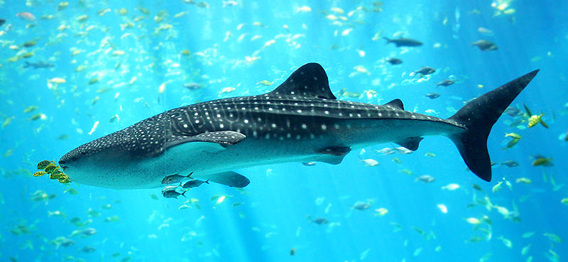
Captive whale shark in the Georgia aquarium. Photo by: Zac Wolf.
The death of one of the world’s largest recorded whale sharks (Rhincodon typus) in the Arabian Sea provoked a sudden global interest in these massive shark. Weighing 14.5 tons, the fish in question made ‘whale shark ‘whale shark’ the number 3 top search in Google Trends on the day the news hit. But, according to a new study in mongabay.com’s open access journal Tropical Conservation Science, more than half the reports filed by journalists were “factually wrong.”
“Reports on landmark events such as this can help educate the public on marine conservation and the ecology of whale sharks,” the authors write, but instead many news articles got their facts wrong and entirely avoided conservation.
Looking at 45 different news sources (including papers, online media, television, and new agencies), the researchers found that 54.4 percent misreported information about the whale shark, including some news media listing the whale shark as a mammal (it’s a fish, not a mammal) while others said it lived in deep, temperate oceans (not shallower, tropical ones).
“Only a minority of the reports discussed conservation of whale sharks. Twenty-two articles (48.9%) reported that the species is threatened, but only six (13.3%) discussed causes of the species decline,” the scientists write, adding that, “only two reports solicited comments from scientists researching whale sharks or sharks in general.”
The whale shark is listed as Vulnerable by the IUCN Red List—and in decline—due to ongoing hunting in some countries, though many nations have banned the practice.
The study also found no difference regarding accuracy of reporting when pitting traditional media versus online media sites.
“It would be ideal […] if journalists were to consult scientific literature, scientifically-accurate repositories of information, or scientists to ensure accuracy prior to the publication of reports and articles,” the authors write.
CITATION: Jaafar, Z. and Giam, X. 2012 Misinformation and omission in science journalism. Tropical Conservation Science Vol. 5(2):142-149.
Related articles
Genetic analysis reveals 79 new species of sharks and rays, many likely endangered
(06/27/2012) Analyzing the DNA sequences of 4,383 specimens of sharks and rays, researchers have discovered 79 potentially new species, raising both the known diversity of this predacious family and concerns that many species are likely more imperiled than thought. Already 32 percent of open ocean sharks and rays are considered threatened with extinction by the IUCN Red List, due largely to overfishing, finning, bycatch, and prey depletion.
Manta rays tracked by satellite
(05/11/2012) Satellite tracking technology has revealed new insights into the behavior of manta rays, reports the Wildlife Conservation Society (WCS). The findings are published in this week’s issue of the journal PLoS.
Camera traps go under the ocean, seeking sharks
(03/12/2012) Remote camera traps, which have become a hugely important conservation tool on land during the past decade, have now gone underwater. Marine biologists have used underwater video camera traps to compare the population of Caribbean reef sharks (Carcharhinus perezii) in Belize’s protected areas versus fishing areas in a new study in the open-access journal PLoS ONE. Conducted from 2005-2010, the study found that reef sharks benefited significantly from conservation areas.